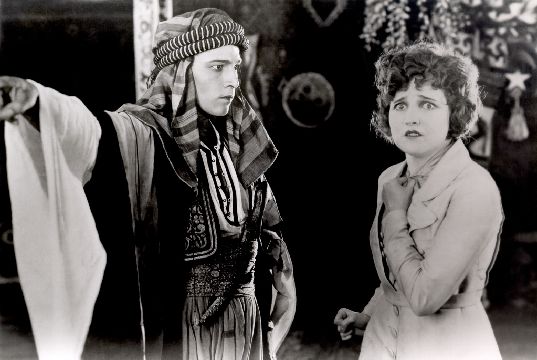The Son of the Sheik (1926) 
“”An eye for an eye-a hate for a hate-that my girl, is the law of the tribe.””

Director: George Fitzmaurice
Cast: Rudolph Valentino, Vilma Bánky, George Fawcett
Synopsis: The son of the sheik and a dancing girl fall in love, but when he is made to believe she has betrayed him he seeks revenge.
George Fitzmaurice’s The Son of the Sheik bears the rare distinction of being both one of the earliest examples of a Hollywood sequel and one of the first movies to be released following the death of its leading man. Eleven days before it went on general release, Rudolph Valentino died of peritonitis at the age of 31. His death had provoked unprecedented displays of public grief, and naturally ensured the box office success of The Son of the Sheik, the belated sequel to his 1921 box-office smash, The Sheik.
Valentino plays both the sheik and his son in this torrid romance. Ahmed, the sheik’s son, falls for the charms of Yasmin (Vilma Banky), who is forced to dance for a band of cutthroats so that they can fleece her admirers of their purses. Ahmed falls prey to their dastardly plot, but bravely refuses to pay his captors any money, even though one of them tortures him by plucking one of his armpit hairs. It has to be said now that Ahmed’s a bigger man than me – just watching that act of blatant cruelty was enough to make my eyes water. Anyway, Ahmed escapes, thanks to the help of his mates, and later, mistakenly believing Yasmin to be in on the plot, abducts her so that he can exact his revenge.
The Son of the Sheik is a fairly entertaining silent action-romance, which successfully incorporates subtle hints of parody into its straightforward plot. The importance of the visuals in the absence of sound is obvious, and Fitzmaurice and cinematographer George Barnes capture some marvellously atmospheric shots thanks to dramatic use of lighting. The camera loved Valentino, and seeks him out to the detriment of his co-stars – although leading lady Banky is equally delectable, and they concoct a satisfying level of sexual chemistry. Interestingly, Ahmed’s father is described as ‘English born, desert-bred,’ as is his mother so that there is no Arab blood in Ahmed, thus making it socially acceptable for him to have an affair with Yasmin, the daughter of a French expatriate. Such things were important back then, when interracial unions were frowned upon. An introductory title also reveals that the story takes place ’Not east of Suez but South of Algiers,’ reportedly to deflect any lawsuits from the lawyers of T. E. Lawrence, upon whom the character of the sheik’s son was allegedly closely based.
Regardless of on whom – if anyone – the character of Ahmed was based, he cuts a dashing figure, although the cigarette hanging from one corner of his mouth looks just a little bit incongruous. Also contrary to the typical profile of a hero is the moment when, having kidnapped Yasmin under the misconception that she was responsible for his own kidnapping, Ahmed proceeds to have his way with her. It’s all done in the best possible taste, of course, and no doubt had legions of grieving women clutching their bosoms with envious lust back in the 1920s, but his behaviour might be a touch unpalatable for modern audiences.
(Reviewed 10th july 2012)
httpv://www.youtube.com/watch?v=NeDaP5qEXTo
